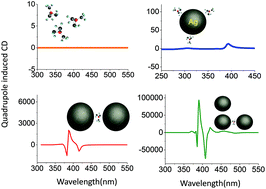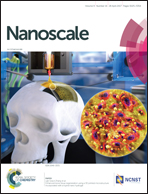A giant chiroptical effect caused by the electric quadrupole†
Abstract
Recently, there has been great interest in studying ultrasensitive detection and characterization of biomolecules using plasmonic particles, because they are of considerable importance in biomedical science and pharmaceutics. So far, all the theories on plasmon-induced circular dichroism (CD) have been based on the dipole approximation; the electric quadrupolar contribution is generally considered to be relatively small and neglected. Here we demonstrate that the electric quadrupolar contribution not only cannot be ignored, but it also plays a key role in many cases. Particularly, for the chiral medium that possesses preferential molecular orientations and is located at the hotspot of plasmonic nanostructures, the plasmonic CD strength contributed by molecular electric quadrupoles (EQs) can be two orders of magnitude higher than that contributed by molecular electric/magnetic dipoles. Unlike the case of the dipole approximation, molecular EQ associated plasmonic CD activity appears mainly at the plasmonic resonance absorptions that facilitate the optically enhanced near-field with steep electric field gradients, and is correlated with the boosted emission rate of a molecular EQ. Based on such physical understandings, we can design nanostructures to realize a giant chiroptical effect using the EQ contribution according to the requirements, which provide a new strategy for ultrasensitive detection and quantification of molecular chirality.



 Please wait while we load your content...
Please wait while we load your content...